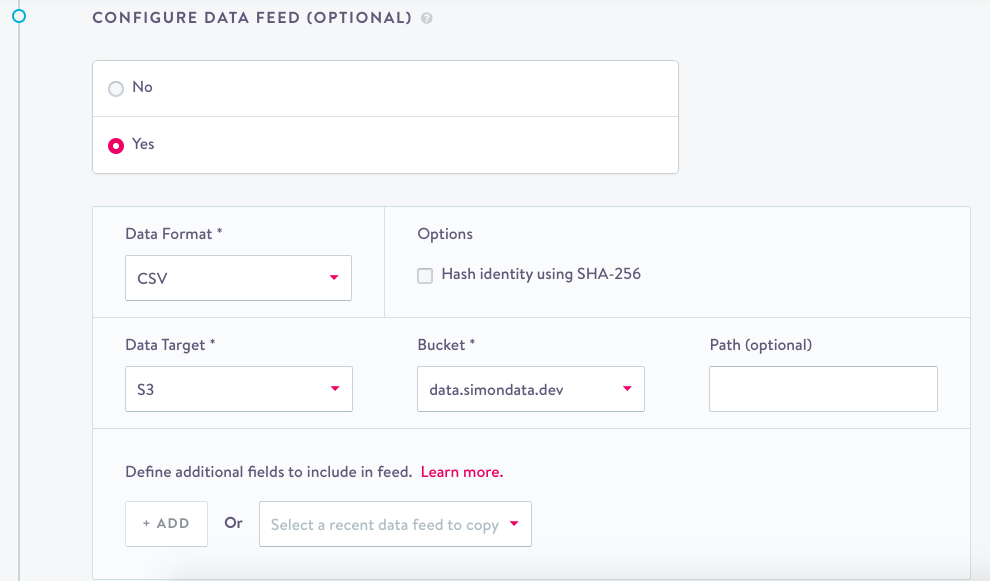We support publishing data feeds to an Amazon S3 bucket or SFTP endpoint. This allows you to export contacts as they enter (or exit) a flow, and record the occurrence of other events. The file path, type, naming, schema, control protocol, and optional conditions for Simon data feeds are broken out below.
Usage
- When setting up a new flow, scroll to the bottom of the page to section titled "Configure Data Feed (Optional).
- Select "Yes".
- Fill in the setup fields and save or launch the flow.

Feed configuration
Data format
Select the format of the data export from the following options:
- CSV
- TSV
- JSONL
(Optional) Hash identity
Optionally, select the checkbox if you want a contact's identity information to be hashed using a SHA-256.
Data target
Select S3 or FTP.
Host/bucket
Enter the name of the S3 bucket or SFTP endpoint you wish to write to. Do not include the scheme (e.g. S3://) or a trailing slash (/) in the name.
Path
Enter the file path you wish to write to. Do not include a beginning or trailing slash (/) in the name. Files are uploaded to the following path: /path/year/month/day.
Personalized content
Add fields to the data feed in addition to the default values in the schema. Add a name and value using the same steps to setup Custom Contexts.
Feed format
File types
Two types of files are produced: data files and control files.
File name
Data files are named by the client_flow_operation_random_YmdHMS with an extension that indicates the file type (either ".csv" or ".jsonl").
Data file schema
The file will include, for each contact, one entry for the data feed and one for each applicable flow action.
| Parameter | Description |
|---|---|
| identifier | Email Address |
| timestamp | Time of export, with format: Y-M-D HH:MM:SS (e.g. "2017-03-14 17:54:13") |
| segment_name | Name of the segment |
| flow_name | Name of the flow |
| action | Flow action associated with the entry |
| variant | Experiment variant (null if there is not one) |
| operation | Type of operation performed (either 'add' or 'remove') |
| Custom Contexts (optional) |
Control files
Control files are named identically to their corresponding data file with the prefix control_ and are always JSON files. They contain a single JSON object with the following structure:
| Parameter | Description |
|---|---|
| delta | Reserved for future use; always true |
| file_count | Reserved for future use; always 1 |
| files | A single-element array of metadata; see below |
The files array will contain a single JSON object that provides information about the corresponding data file. It contains:
| bucket | The specified bucket |
| path | The specified path |
| file_type | Either "csv" or "jsonl" |
| file | Full URL of data file |
| rows | The number of rows in the data file |
| flow_ID | The ID of the flow |
| flow_name | The name of the flow |
Currently this produces one control file for every data file, but in the future it may produce a single control file for many data files.
